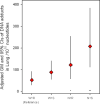Synergistic effects of NAT2 slow and GSTM1 null genotypes on carcinogen DNA damage in the lung
- PMID: 20501762
- PMCID: PMC2882986
- DOI: 10.1158/1055-9965.EPI-09-1195
Synergistic effects of NAT2 slow and GSTM1 null genotypes on carcinogen DNA damage in the lung
Abstract
Background: Polymorphisms in carcinogen detoxification enzymes, NAT2 and GSTM1, have been suggested as susceptibility factors for DNA damage and lung cancer. However, little information is available on DNA adduct burden in the lung tissue and polymorphisms in NAT2 and GST genes. We investigated the independent and combined effects of the metabolic gene polymorphisms of NAT2 and GSTs on DNA adduct formation in different tissues (lung and blood) in lung cancer patients.
Methods: DNA adducts were measured in lung and blood by the (32)P-postlabeling assay. Multiple regression models were used to assess adjusted percent change in DNA adduct levels associated with GST and NAT2 genotypes.
Results: After adjusting for potential confounders, as well as for other GST gene variants, lung adduct levels significantly increased by 150.3% [95% confidence interval (95% CI), 35.4-362.6%] for the GSTM1 null and by 73.9% (95% CI, -3.2% to 212.4%) for the NAT2 slow acetylator genotype, respectively. No association was seen with polymorphisms of other GST genes such as GSTT1 and GSTP1. The high-risk group, the combined GSTM1 null plus NAT2 slow, had significantly enhanced levels of lung adducts by 295% (95% CI, 72.7-803.5%) over those associated with single genes, suggesting a synergistic effect on DNA damage in the target lung tissue.
Conclusions: The increase in DNA adduct levels in lung is associated with the GSTM1 null and NAT2 slow genotypes alone or in combination.
Impact: These results suggest that GSTM1 and NAT2 genotypes play an independent and interactive role in the formation of carcinogen DNA adduct in the lung.
Copyright 2010 AACR.
Figures
Similar articles
-
Modulation of DNA and protein adducts in smokers by genetic polymorphisms in GSTM1,GSTT1, NAT1 and NAT2.Pharmacogenetics. 2001 Jul;11(5):389-98. doi: 10.1097/00008571-200107000-00003. Pharmacogenetics. 2001. PMID: 11470992
-
Glutathione S-transferase and N-acetyltransferase genotypes and asbestos-associated pulmonary disorders.J Natl Cancer Inst. 1996 Dec 18;88(24):1853-6. doi: 10.1093/jnci/88.24.1853. J Natl Cancer Inst. 1996. PMID: 8961976
-
Aromatic DNA adducts and polymorphisms of CYP1A1, NAT2, and GSTM1 in breast cancer.Carcinogenesis. 2002 Feb;23(2):301-6. doi: 10.1093/carcin/23.2.301. Carcinogenesis. 2002. PMID: 11872636
-
[Biomarkers of gentotoxic risk and metabolic polymorphism].Med Lav. 2000 Sep-Oct;91(5):431-69. Med Lav. 2000. PMID: 11189784 Review. Italian.
-
Association of genetic polymorphisms of CYP2E1, NAT2, GST and SLCO1B1 with the risk of anti-tuberculosis drug-induced liver injury: a systematic review and meta-analysis.BMJ Open. 2019 Aug 1;9(8):e027940. doi: 10.1136/bmjopen-2018-027940. BMJ Open. 2019. PMID: 31375612 Free PMC article.
Cited by
-
Genetic Polymorphisms of Xenobiotic Metabolizing Genes (GSTM1, GSTT1, GSTP1), Gene-Gene Interaction with Association to Lung Cancer Risk in North India; A Case Control Study.Asian Pac J Cancer Prev. 2019 Sep 1;20(9):2707-2714. doi: 10.31557/APJCP.2019.20.9.2707. Asian Pac J Cancer Prev. 2019. PMID: 31554367 Free PMC article.
-
Genetic susceptibility to lung cancer--light at the end of the tunnel?Carcinogenesis. 2013 Mar;34(3):487-502. doi: 10.1093/carcin/bgt016. Epub 2013 Jan 24. Carcinogenesis. 2013. PMID: 23349013 Free PMC article. Review.
-
GSTM1 null genotype in COPD and lung cancer: evidence of a modifier or confounding effect?Appl Clin Genet. 2011 Sep 13;4:137-44. doi: 10.2147/TACG.S21517. Print 2011. Appl Clin Genet. 2011. PMID: 23776374 Free PMC article.
-
N-acetyltransferase 1 and 2 polymorphisms and risk of diabetes mellitus type 2 in a Saudi population.Ann Saudi Med. 2015 May-Jun;35(3):214-21. doi: 10.5144/0256-4947.2015.214. Ann Saudi Med. 2015. PMID: 26409796 Free PMC article.
-
Seasonal variations in the levels of PAH-DNA adducts in young adults living in Mexico City.Mutagenesis. 2011 May;26(3):385-91. doi: 10.1093/mutage/geq104. Epub 2010 Dec 30. Mutagenesis. 2011. PMID: 21193517 Free PMC article.
References
-
- Peluso M, Munnia A, Hoek G, et al. DNA adducts and lung cancer risk: a prospective study. Cancer Res. 2005;65:8042–8. - PubMed
-
- Poirier MC. Chemical-induced DNA damage and human cancer risk. Nat Rev Cancer. 2004;4:630–7. - PubMed
-
- Veglia F, Loft S, Matullo G, et al. DNA adducts and cancer risk in prospective studies: a pooled analysis and a meta-analysis. Carcinogenesis. 2008;29:932–6. - PubMed
-
- Hecht SS. Tobacco smoke carcinogens and lung cancer. J Natl Cancer Inst. 1999;91:1194–210. - PubMed
-
- Hecht SS. Tobacco carcinogens, their biomarkers and tobacco-induced cancer. Nat Rev Cancer. 2003;3:733–44. - PubMed
Publication types
MeSH terms
Substances
Grants and funding
LinkOut - more resources
Full Text Sources
Other Literature Sources
Medical
Research Materials
Miscellaneous


